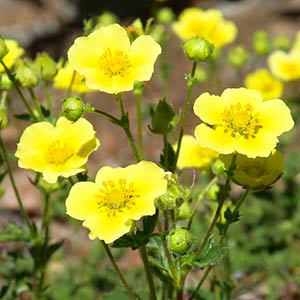Drymocallis pseudorupestris
Drymocallis lactea
cliff drymocallis, cliff woodbeauty, false rock loving cinquefoil, Rocky Mountain sticky cinquefoil
Nevada cinquefoil, Sierran woodbeauty
elongate.
short.
openly tufted to loosely spaced, (0.3–)0.6–4 dm;
base 1–3 mm diam., ± densely septate-glandular.
tufted, (0.3–)1.5–6(–6.5) dm;
base 1–2.5 mm diam., not or sparsely, sometimes moderately, septate-glandular.
glabrate or sparsely to ± densely hairy;
basal (2–)3–16 cm, leaflet pairs (2–)3–4(–5);
terminal leaflet broadly obovate-cuneate to flabellate, 0.2–3(–4) × 0.5–3 cm, teeth single or double, 2–15 per side, apex usually rounded to truncate, sometimes obtuse;
cauline 0–2, reduced, leaflet pairs 2–3.
usually sparsely to moderately hairy, sometimes glabrate;
basal (2–)5–20(–30) cm, leaflet pairs (2–)3–4(–5);
terminal leaflet broadly obovate to cuneate, 1–4 × 0.7–3.5 cm, teeth usually single, 4–10(–14) per side, apex usually rounded to obtuse, rarely acute;
cauline 1–2, reduced, leaflet pairs 2–3.
2–40-flowered, not or ± leafy, open, 1/6–3/4(–4/5) of stem, ± wide, branch angles (10–)20–40(–50)°.
(2–)5–30(–50)-flowered, not leafy, open, (1/6–)1/5–1/2(–4/5) of stem, narrow to wide, branch angles 10–40(–50)°.
3–20 (proximal to 40) mm, not or sparsely to moderately short-hairy, predominantly septate-glandular.
2–10 (proximal to 30) mm, predominantly short-hairy, sometimes velutinous, not or sparsely, sometimes moderately, septate-glandular.
opening widely;
epicalyx bractlets linear to elliptic, 2–6 × 1–2 mm;
sepals spreading, 4–7(–9) mm, apex acute to obtuse, apiculate;
petals overlapping or not, spreading, cream-white to pale yellow (red-tinged in var. crumiana), narrowly to broadly obovate, 4–12 × 3–11 mm, longer than sepals;
filaments 1–4 mm, anthers 0.7–1.2 mm;
styles thickened, 1–1.5 mm.
opening widely;
epicalyx bractlets linear-lanceolate to narrowly elliptic, 2–5 × 0.5–1.5 mm;
sepals spreading, 3–8(–9) mm, apex usually acute, sometimes obtuse and apiculate;
petals ± overlapping, spreading, cream-white to bright yellow, broadly obovate, (3–)4–8(–10) × 3–8 mm, usually longer than, rarely equal to, sepals;
filaments 1–3(–3.5) mm, anthers 0.6–1 mm;
styles thickened, 1 mm.
light brown, 1 mm.
light brown, 1 mm.
Drymocallis pseudorupestris
Drymocallis lactea
Varieties 3 (3 in the flora).
Drymocallis pseudorupestris occurs from Alberta and Washington to California and Utah, mostly in montane habitats; it is the species most often associated with rocky habitats, including talus slopes, for which its relatively elongate caudex branches are an obvious adaptation. Vestiture is dominated by abundant septate glands on stems and in the inflorescences. Except for var. pseudorupestris, which occurs only in the northeastern part of the species range, plants are relatively short, usually less than 2.5 dm. Three intergrading varieties accommodate the extremes at the northeastern and southern ends of the range.
(Discussion copyrighted by Flora of North America; reprinted with permission.)
Varieties 2 (2 in the flora).
Drymocallis lactea has had a well-established identity as Potentilla glandulosa var. (or subsp.) nevadensis; however, the epithet lactea has priority at species rank and avoids possible confusion with P. nevadensis Boissier. D. D. Keck (in J. Clausen et al. 1940) based his concept of P. glandulosa subsp. nevadensis on white-petaled plants with narrow inflorescences, the common form in the central Sierra Nevada and south. His map and annotations, however, include populations with yellow petals and widely branched inflorescences from northern California and adjacent Oregon. The two extremes merge in the northern Sierra Nevada, and populations in the North Coast Ranges of California also are problematic; the extremes are accordingly treated here as varieties of a single species. The inclusion by Keck of Washington in the species range might have been based on specimens here assigned to P. pseudorupestris.
Drymocallis lactea can be distinguished from sympatric species by its relatively large, overlapping petals, non-leafy inflorescences, and singly toothed leaflets. Pedicels and distal stems are usually densely short-hairy with relatively few or no glandular hairs (in contrast to D. pseudorupestris), and septate glands are usually absent from stem bases (in contrast to D. hansenii). The distinction between D. lactea and D. pseudorupestris breaks down at the margin of the species range in Nevada and Oregon.
(Discussion copyrighted by Flora of North America; reprinted with permission.)
1. Stems (1–)2–4 dm, bases (1.5–)2–3 mm diam.; basal leaves (4–)7–16 cm; terminal leaflets (1–)2–3(–4) cm, teeth usually double, (5–)8–15 per side; flowers (5–)10–40; petals 6–12 × 5–11 mm, widely overlapping; filaments 2–4 mm. | var. pseudorupestris |
1. Stems (0.3–)0.6–2.5 dm, bases 1–2(–3) mm diam.; basal leaves (2–)3–9(–15) cm; terminal leaflets 0.2–2(–4) cm, teeth single or ± double, 2–8(–12) per side; flowers 2–12(–20); petals 4–8(–9) × 3–6(–8) mm, not or ± overlapping; filaments 1–2.5(–3) mm | → 2 |
2. Basal leaves: leaflet pairs (2–)3(–4); hypanthia and sepals not bristly or bristles less than 1 mm; short hairs sparse to moderately abundant on stems and pedicels (sometimes absent); styles usually golden brown, rarely reddish. | var. saxicola |
2. Basal leaves: leaflet pairs 3–4(–5); hypanthia and sepals prominently bristly, bristles 1–1.5 mm; short hairs absent or sparse on stems and pedicels; styles usually dark red, rarely golden brown. | var. crumiana |
1. Inflorescences narrow, branch angles 10–20°; petals cream-white to pale yellowish; pedicels and stems not or sparsely septate-glandular. | var. lactea |
1. Inflorescences wide, branch angles mostly 20–40°; petals usually pale to bright yellow; pedicels and stems sometimes moderately septate-glandular. | var. austiniae |
- Local floras:
BC,
CA,
OR
- Local Web sites:
CalFlora,
CalPhotos,
Flora NW,
PNW Herbaria
WildflowerSearch
iNaturalist (observations)
USDA Plants Database
- LBJ Wildflower Center
- SEINet
- Plants of the World Online
- Encyclopedia of Life
- Wikipedia
- Google Image Search


